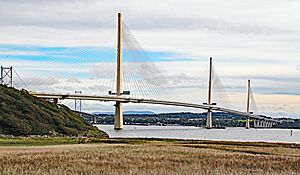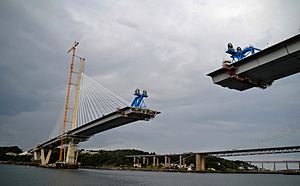Queensferry Crossing facts for kids
Quick facts for kids Queensferry Crossing |
|
|---|---|

The Queensferry Crossing photographed in November 2017
|
|
| Coordinates | 56°00′17″N 3°24′45″W / 56.0046°N 3.4124°W |
| Carries | |
| Crosses | Firth of Forth |
| Locale | Edinburgh and Fife, Scotland |
| Characteristics | |
| Design | Cable-stayed bridge |
| Total length | 2,700 metres (8,858 ft) |
| Longest span | 650 metres (2,133 ft) |
| History | |
| Constructed by | Forth Crossing Bridge Constructors (FCBC) |
| Construction begin | September 2011 |
| Construction end | 27 August 2017 |
| Construction cost | £1.35 billion |
| Opened | 30 August 2017 |
| Inaugurated | 4 September 2017 |
The Queensferry Crossing is a modern road bridge in Scotland. It was once called the Forth Replacement Crossing. This bridge crosses the Firth of Forth, a long sea inlet, connecting Edinburgh (at South Queensferry) and Fife (at North Queensferry). It carries the M90 motorway.
Ideas for a new bridge here started in the 1990s. This was because the older Forth Road Bridge was getting very busy. In 2004, engineers found some problems with the Forth Road Bridge. This made building a new bridge even more important.
In 2007, the decision was made to build a replacement bridge. The old Forth Road Bridge would stay open for buses, bikes, and walkers. Construction of the Queensferry Crossing began in late 2011.
The Queensferry Crossing is a special type of bridge called a cable-stayed bridge. It has three tall towers. The bridge is about 2.7 kilometers (1.7 miles) long. New roads, about 4 kilometers (2.5 miles) long, were also built to connect to the bridge.
The bridge was supposed to open in December 2016. However, there were some delays, so it opened on August 30, 2017. It is the third major bridge across the Forth at Queensferry. The others are the Forth Road Bridge (opened 1964) and the Forth Rail Bridge (opened 1890). People voted on the name, and "Queensferry Crossing" was chosen in 2013. Queen Elizabeth II officially opened the bridge on September 4, 2017. This was exactly 53 years after she opened the Forth Road Bridge.
Contents
Why a New Bridge Was Needed
People have crossed the Forth at Queensferry for a very long time. In the 11th century, Queen Margaret started a free ferry here. This ferry helped pilgrims travel north to St Andrews. Later, the Forth Road Bridge was built in the same area. It opened in 1964.
Problems with the Old Bridge
The Forth Road Bridge was designed to last for 120 years. However, by the early 2000s, it was carrying much more traffic than planned. It was built for about 11 million vehicles each year. But by 2006, this number had grown to 23 million vehicles.
Between 2003 and 2005, inspections showed a problem. The main cables of the bridge were losing strength because of rust. Experts thought the problem would get worse quickly. They worried that traffic might need to be limited by 2014.
Because the bridge was so important for transport, closing it would cause big economic problems. Building a new bridge was estimated to take up to 11 years. So, in 2007, the decision was made to build a new bridge.
Planning the Queensferry Crossing
In 2007, a study looked at different ways to cross the Forth. It suggested building a cable-stayed bridge west of the Forth Road Bridge. This option was cheaper and faster to build than a tunnel.
In December 2007, the Scottish Government announced the new bridge. They estimated it would cost between £3.25 billion and £4.22 billion. It was called "the largest construction project in a generation in Scotland."
Who Opposed the Project?
Some groups were against the new bridge. They worried about the environment, more traffic, and the high cost. Groups like the ForthRight Alliance thought the bridge was "unwelcome and unnecessary." Another group, the Forth Tunnel Action Group, wanted a tunnel instead. They believed a tunnel would be cheaper and better for the environment in the long run.
Funding and Legal Steps
At first, there were ideas to fund the bridge using a special trust. But in 2008, the Scottish Government decided to use public money. The estimated cost was then updated to between £1.72 billion and £2.34 billion. The plan was for the new bridge to open by 2016. The old bridge would be kept for public transport, cyclists, and pedestrians.
Experts from Arup and Jacobs managed the project. Environmental studies and public meetings took place. In January 2011, the law to build the Forth Crossing was passed.
Choosing the Builders
In 2009, companies were asked to bid for the construction contract. Two main groups of companies put in bids: Forthspan and Forth Crossing Bridge Constructors (FCBC).
In March 2011, the Scottish Government chose FCBC as the main builder. Their bid was £790 million. Other companies also won contracts for smaller parts of the project, like traffic management systems and road upgrades.
Building the Queensferry Crossing
Work on the new bridge started in September 2011. The first jobs were building the approach roads on the northern side. Large sections of the bridge deck, each 12 meters (39 feet) long and 40 meters (131 feet) wide, were made in China and Spain. They were then shipped to Scotland.
The bridge towers grew taller over time. By August 2015, they reached 160 meters (525 feet), making it the tallest bridge in the UK at that time. The finished towers stand at 207 meters (679 feet) high.
During construction, there were some delays. High winds caused work to stop for many days in 2016 and 2017. This pushed back the opening date. The bridge finally opened to traffic on August 30, 2017.
About the Bridge Itself
The Queensferry Crossing is a cable-stayed design with three towers. Each tower is 207 meters (679 feet) tall. Including the parts that connect to the land, the bridge is 2.7 kilometers (1.7 miles) long. When it opened, it was the longest triple-tower cable-stayed bridge in the world.
The bridge carries cars, motorcycles, and large trucks. Buses, cyclists, and pedestrians still use the old Forth Road Bridge. The Queensferry Crossing has special wind shields. These help the bridge stay open even in strong winds, which often caused problems for the older bridge.
The bridge is the third crossing at Queensferry. It is located west of the Forth Road Bridge. The northern end is at St Margaret's Hope, and the southern end is near Port Edgar. The middle tower of the bridge was built on a small island in the Forth called Beamer Rock.
Naming the Bridge
The project was first called the Forth Replacement Crossing. In 2013, the public voted on a new name. Five names were suggested: Caledonia Bridge, Firth of Forth Crossing, Queensferry Crossing, Saltire Crossing, and St Margaret's Crossing. "Queensferry Crossing" received the most votes, with over 12,000 people choosing it.
Connecting Roads
About 4 kilometers (2.5 miles) of new and improved roads were built. These roads connect the Queensferry Crossing to the existing M9 and M90 motorways. The Queensferry Crossing itself is built to motorway standards, carrying the M90 across the Forth. Before, the M90 ended north of the Forth Road Bridge.
Major Junctions
- Admiralty Junction: This junction was mostly unchanged, but a bus lane was added. It is now Junction 1C of the M90.
- Ferrytoll Junction: This junction was redesigned to allow access to the new bridge and keep access to the Forth Road Bridge for public transport. It is now Junction 1B of the M90.
- South Queensferry Junction: A new junction was built here to connect the M90 to the southern end of the new bridge. It is now Junction 1A of the M90.
- M9 Junction 1a: This junction was upgraded to allow direct access from the M9 to both the Forth Road Bridge and the new Queensferry Crossing. This helps traffic flow better, especially at busy times.
Smart Traffic System
A "smart traffic system" was put in place along the entire route. This system helps manage traffic. It can show different speed limits and lane closures on signs above the road.
Archaeological Discoveries
Before construction began, archaeologists explored the area. They found very old remains from the Mesolithic period (Middle Stone Age) on both sides of the Forth.
On the north side, they found two structures made of posts and pits around them. These were from the mid to late Mesolithic period.
On the south side, near Echline, they found parts of a sunken-floor building. This building had an oval pit, about 7 meters (23 feet) long. Inside, there was a fireplace, stone tools, and animal bones. Tests showed it was about 8,300 years old. This makes it the oldest known house in Scotland! They also found other ancient pits from the Neolithic and Bronze Ages.
Images for kids







